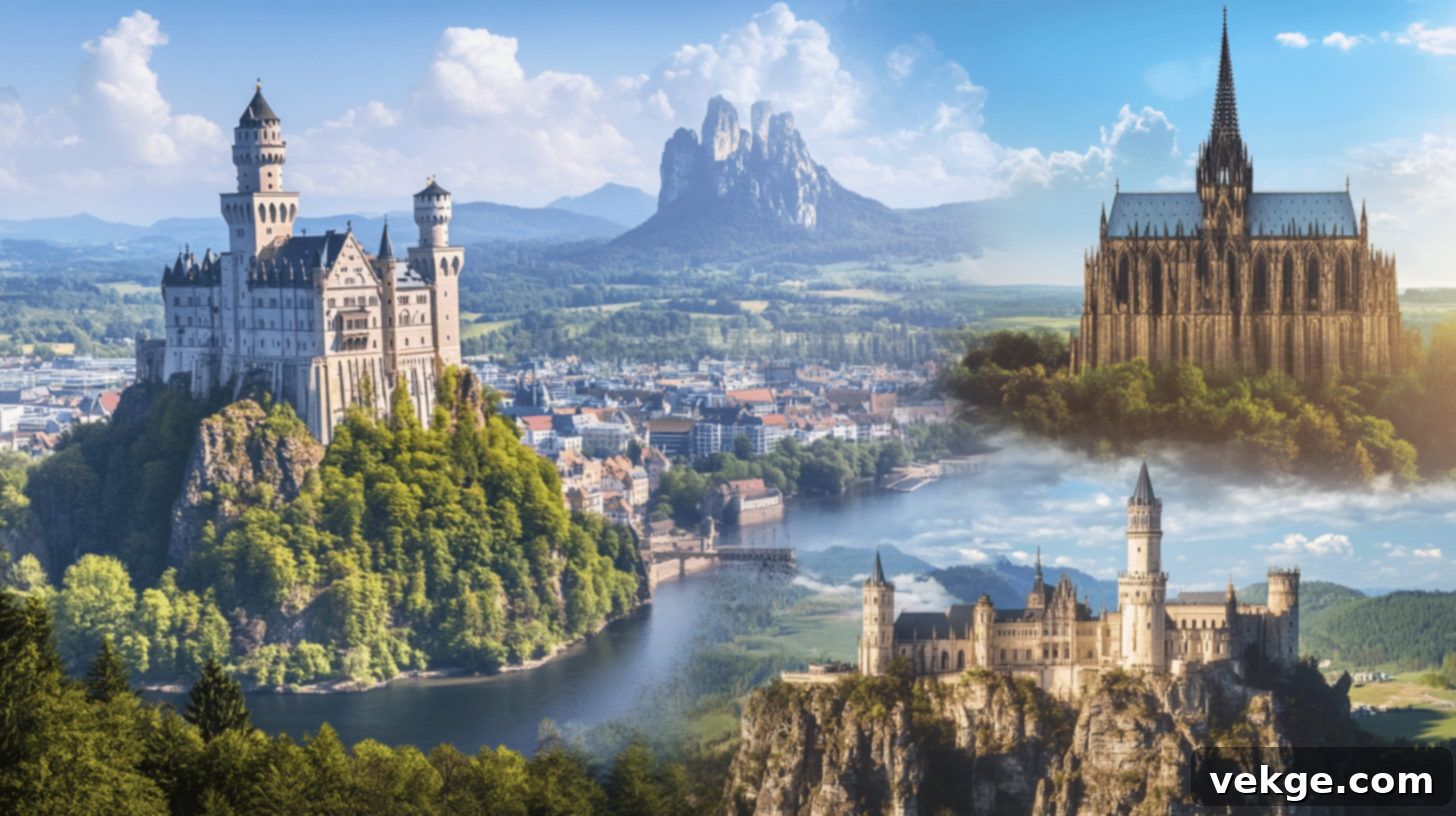Germany’s Must-Visit Landmarks: A Comprehensive Guide to Famous Buildings, Castles & Natural Wonders
Are you dreaming of an unforgettable journey through Germany, eager to discover its most famous buildings, majestic castles, and breathtaking natural wonders? Look no further! This captivating country, rich in history and diverse landscapes, offers an unparalleled travel experience for every kind of adventurer.
From the whimsical spires of fairy-tale castles nestled in dense forests to the vibrant energy of historic city gates and the serene beauty of towering mountains, Germany truly has something special for every traveler. Our expertly curated guide brings together some of the nation’s absolute must-see places, packed with all the essential information you need for a seamless and memorable trip.
We’ve meticulously gathered insights on the optimal times to visit for the best experience, provided easy-to-follow directions on how to get there, and included fascinating facts that highlight what makes each destination truly unique. This simple yet comprehensive breakdown delves into the rich history of each landmark, offering practical tips to ensure your visit is both smooth and enjoyable.
Consider this your ultimate roadmap to exploring Germany’s most amazing places. Prepare to be enchanted by ancient traditions, awe-struck by architectural marvels, and inspired by the stunning natural beauty that defines this incredible European gem!
Iconic Landmarks of Germany You Can’t Afford to Miss
1. Neuschwanstein Castle
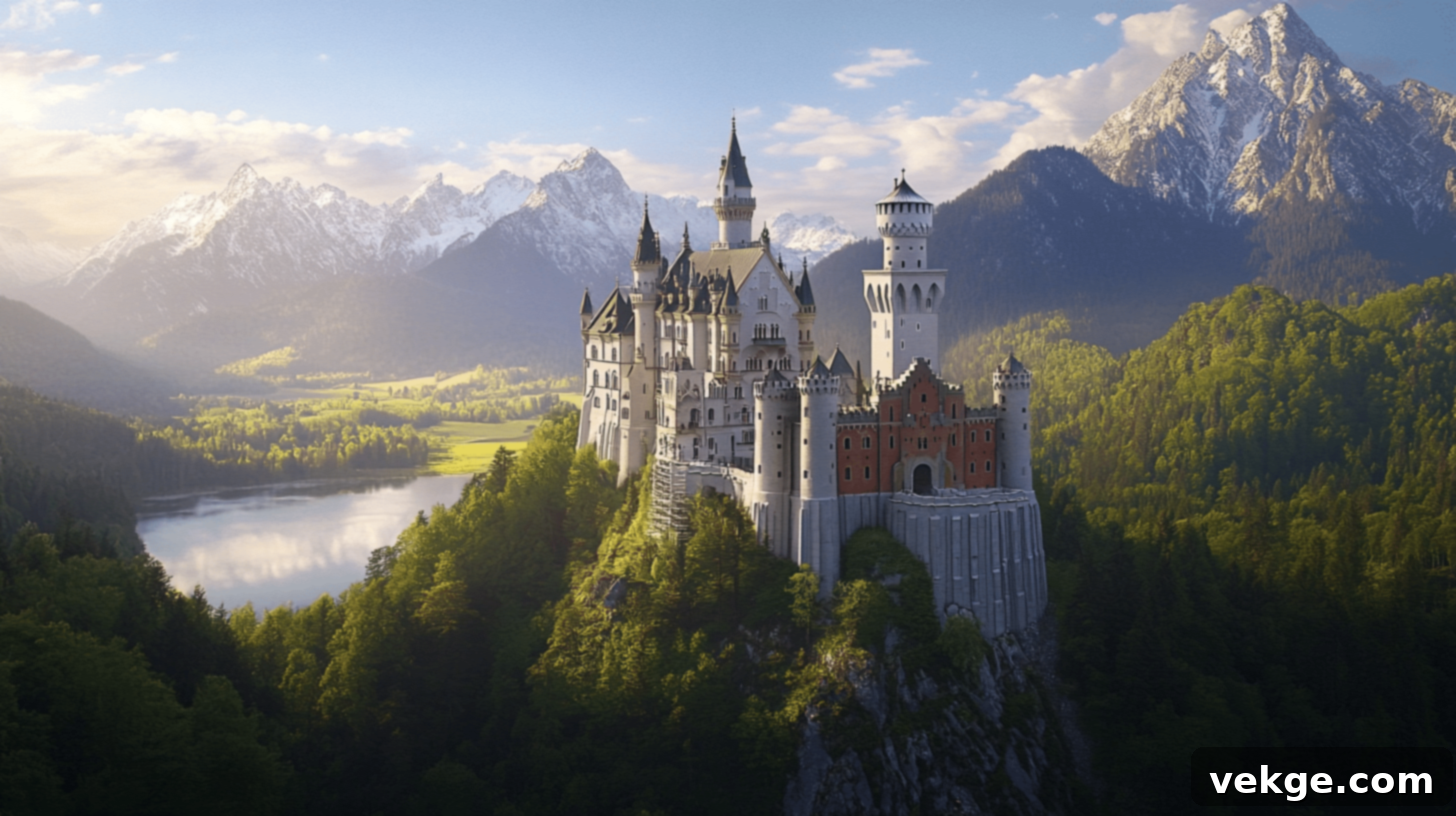
History and Importance: Often hailed as the “fairy tale castle,” Neuschwanstein was commissioned by King Ludwig II of Bavaria and built between 1869 and 1886. This architectural marvel stands as a magnificent representation of 19th-century Romanticism, a period when medieval architectural styles were revived. Although Ludwig’s mysterious death prevented its full completion, its breathtaking beauty quickly earned it global fame. It famously served as the direct inspiration for Disney’s Sleeping Beauty Castle, cementing its place as one of the world’s most iconic and recognizable structures.
When to Visit: For a more serene experience with fewer crowds, plan your visit during the shoulder seasons: April to June or September to October. While summer months (July-August) bring longer daylight hours and warmer weather, they also see a significant surge in tourists, leading to extensive lines. Winter offers a different kind of magic, transforming the castle into a snow-covered wonderland, perfect for picturesque photographs.
Local Travel Tips: Booking your tickets online several weeks, or even months, in advance is highly recommended, especially during peak season, as entry is by guided tour only. Once in Füssen, you can easily reach the castle by taking local bus routes #73 or #78. Alternatively, for those who enjoy a scenic walk, you can hike up from the charming village of Hohenschwangau, offering stunning views along the way.
Fun Facts: Despite its grand scale, only 14 of the planned 200 rooms were ever finished. King Ludwig II, known for his reclusive nature and fascination with art, lived in the castle for a mere 172 days before his untimely death.
2. Cologne Cathedral (Kölner Dom)

History and Importance: A true testament to enduring human endeavor, the construction of Cologne Cathedral began in 1248 but wasn’t finally completed until an astonishing 632 years later, in 1880. This colossal Gothic masterpiece, a UNESCO World Heritage site, miraculously survived the devastating World War II bombings that destroyed much of Cologne. It houses the revered gilded Shrine of the Three Kings, believed to contain the relics of the Biblical Magi, making it a significant pilgrimage site.
When to Visit: To avoid the largest crowds, particularly during summer, aim for an early morning visit or plan your trip on a weekday. The cathedral square becomes especially vibrant and festive in December, hosting one of Germany’s most enchanting Christmas markets, offering a unique and memorable experience.
Local Travel Tip: For unparalleled panoramic views of Cologne and the mighty Rhine River, challenge yourself to climb the 533 steps to the top of the south tower. The cathedral’s prime location directly across from Cologne’s main train station makes it incredibly accessible for travelers arriving by rail.
Fun Facts: As mentioned, its construction period spanned over six centuries. The cathedral is also home to the St. Peter’s Bell, the largest freely swinging church bell in the world, weighing an incredible 24 tons and resonating with a deep, powerful sound.
3. Brandenburg Gate, Berlin (Brandenburger Tor)
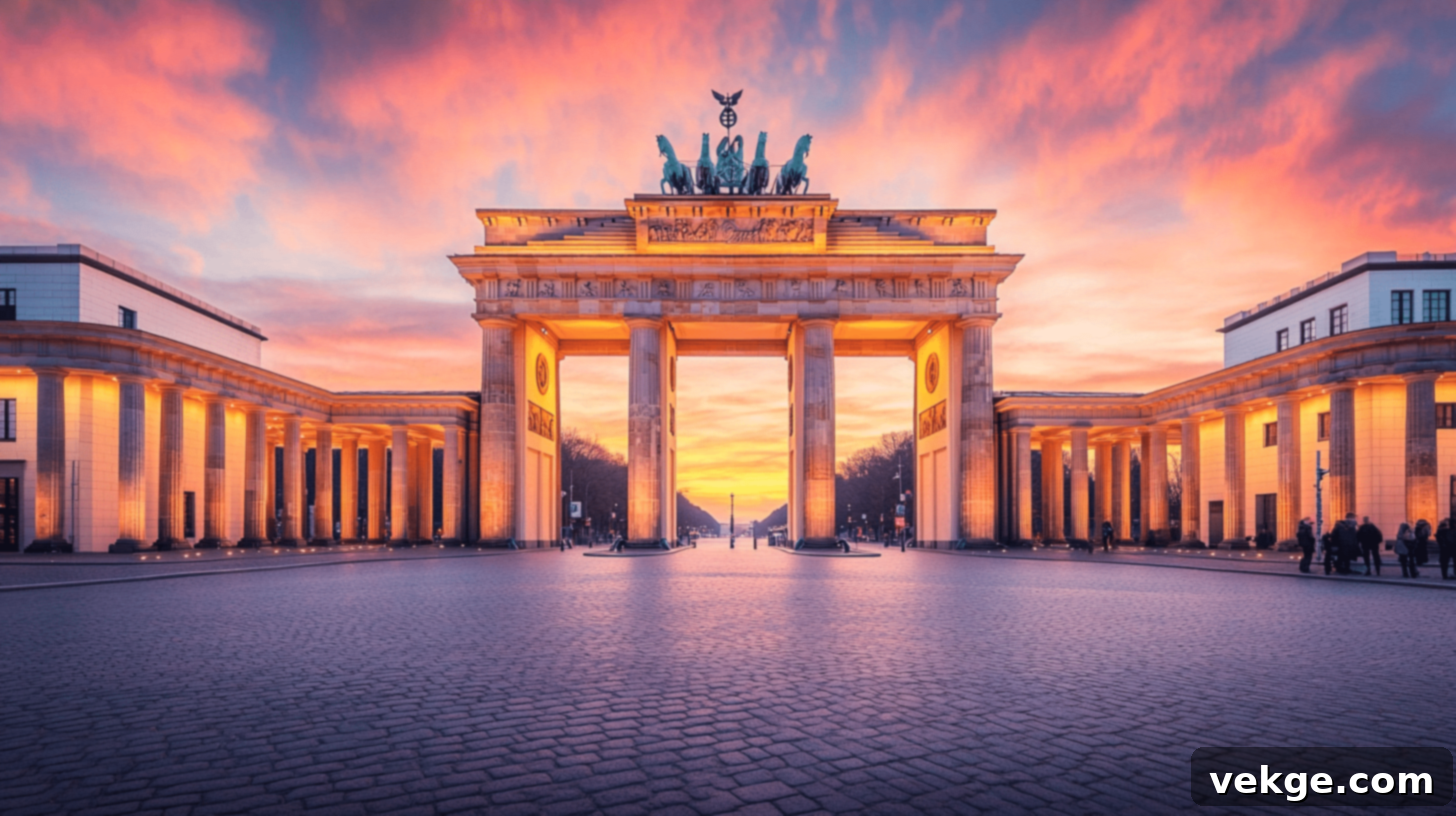
History and Importance: Erected in 1791, the Brandenburg Gate was initially conceived as a symbol of peace. However, its history mirrors Germany’s tumultuous past, later becoming an infamous marker of the division between East and West Berlin during the Cold War. Following the fall of the Berlin Wall in 1989, it underwent a powerful transformation, emerging as Germany’s most potent and widely recognized symbol of unity and freedom.
When to Visit: For the best photographs without throngs of tourists, visit early in the morning. October 3rd, German Unity Day (Tag der Deutschen Einheit), is a particularly significant time, marked by nationwide celebrations and often special events around the gate, offering a unique cultural experience.
Local Travel Tips: The Brandenburg Gate is stunning when illuminated at night, offering a different, more atmospheric perspective. Its central location makes it easy to combine your visit with other nearby historical sites, such as the Reichstag Building (which requires an online reservation in advance) and the profound Memorial to the Murdered Jews of Europe (Holocaust Memorial).
Fun Facts: In 1806, Napoleon Bonaparte famously stole the Quadriga statue (a chariot drawn by four horses) from atop the gate, taking it to Paris. After his defeat, it was triumphantly returned to Berlin, and the goddess of victory in the statue was subsequently given an Iron Cross, symbolizing triumph and resilience.
4. Saxon Switzerland National Park

History and Importance: This unique natural wonderland, named by Swiss artists who found its landscape strikingly similar to their mountainous homeland, was granted protected status in 1990. Characterized by its dramatic sandstone mountains, deep gorges, and lush forests, the park boasts over 700 climbing peaks, making it a world-renowned destination for rock climbers and hikers alike.
When to Visit: The period from May to October is ideal for hiking and outdoor activities, with pleasant weather and full access to trails. Autumn brings spectacular foliage, transforming the landscape into a vibrant tapestry of colors. Winter offers a starkly beautiful scene, with frosty rock formations and a serene, quiet atmosphere.
Local Travel Tips: Accessing the park is convenient; take the S-Bahn train S1 from Dresden directly to Bad Schandau, a central hub for the park. A perfect starting point for iconic views is the Bastei Bridge, a breathtaking sandstone bridge offering panoramic vistas over the Elbe River and the surrounding rock formations.
Fun Facts: The striking Elbe Sandstone formations that dominate the park’s landscape were once the seabed of an ancient ocean, approximately 100 million years ago. This dramatic scenery profoundly inspired romantic landscape paintings, most notably by the acclaimed German artist Caspar David Friedrich.
5. East Side Gallery, Berlin

History and Importance: Following the joyous fall of the Berlin Wall in 1989, a 1.3-kilometer section of the former border barrier was transformed into the world’s longest open-air gallery. In 1990, 118 artists from 21 countries painted murals on this section, each telling a story of hope, political change, and the pursuit of freedom. Today, it stands as a powerful and vibrant memorial to that pivotal moment in history.
When to Visit: To experience the art and reflective atmosphere without large crowds, visit early in the morning. Summer evenings offer pleasant walking weather, allowing for a leisurely stroll along the gallery as the day cools down.
Local Travel Tips: The gallery is easily accessible via the Warschauer Straße S-Bahn station. Dedicate at least 30 minutes to an hour to walk the full length of the gallery, allowing time to appreciate the diverse artworks and reflect on their historical context.
Fun Facts: One of the most famous murals, “The Fraternal Kiss” by Dmitri Vrubel, depicts Soviet leader Leonid Brezhnev kissing East Germany’s Erich Honecker. This iconic image is based on a real photograph taken during the 30th anniversary of the German Democratic Republic in 1979.
6. Lake Constance (Bodensee)
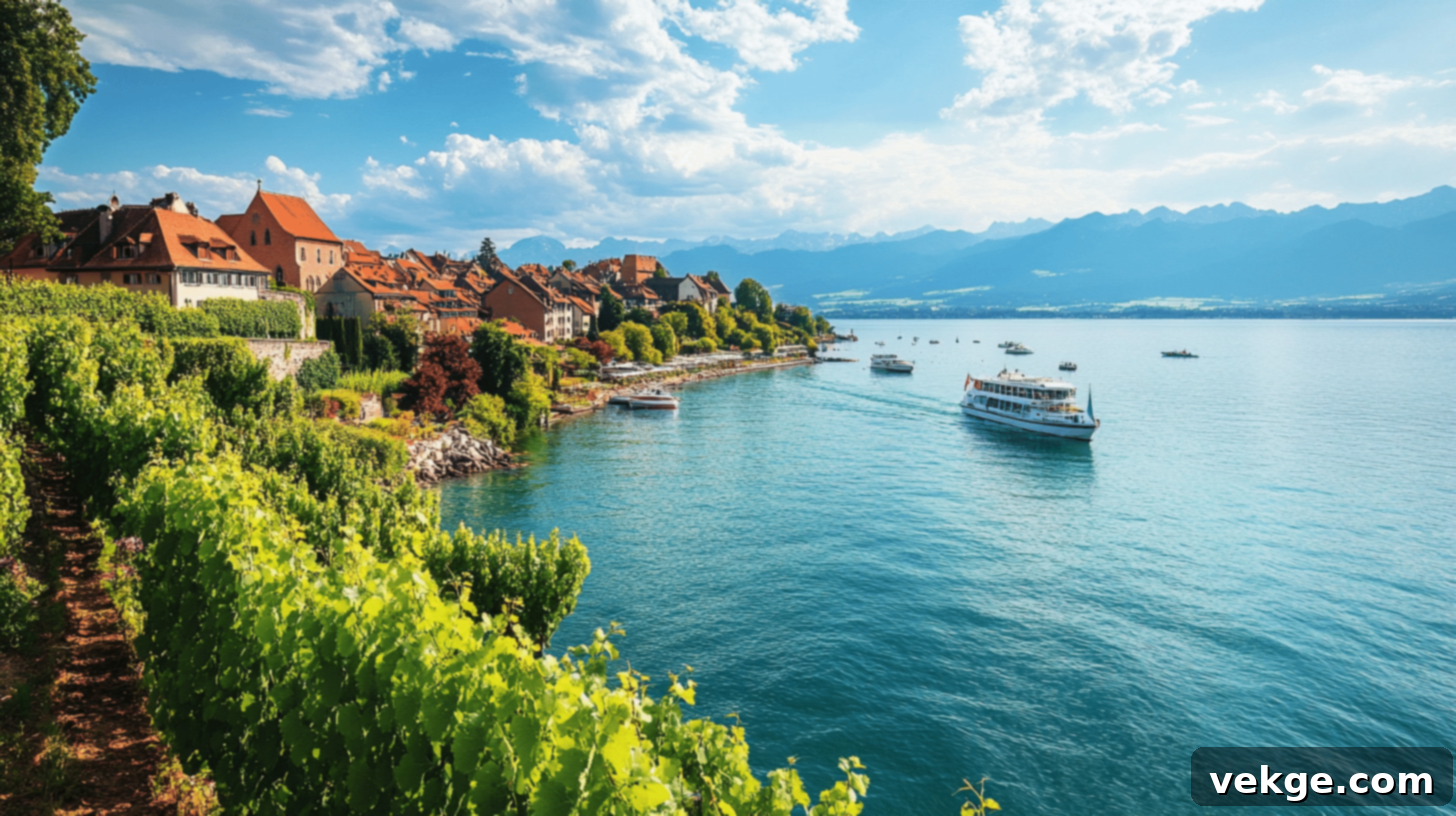
History and Importance: Nestled at the foot of the Alps, Lake Constance is Central Europe’s third-largest lake, a magnificent body of water formed by the immense Rhine glacier during the last Ice Age. Its unique geographical position means it borders three countries: Germany, Switzerland, and Austria. The region has a rich history, with evidence of Roman settlements and medieval towns like Konstanz and Lindau that maintained crucial commercial importance throughout centuries.
When to Visit: The months from April to October are ideal for enjoying a wide range of water activities, boat tours, and various local festivals. During winter, boat services are reduced, but the charming lakeside towns still offer a tranquil and picturesque escape.
Local Travel Tips: Consider purchasing the Lake Constance Card (Bodensee Card) for unlimited public transport and discounts on many attractions, which can significantly enhance your exploration of the region. A must-see is Mainau Island, also known as the “Flower Island,” renowned for its stunning botanical gardens and vibrant floral displays year-round.
Fun Facts: Due to its unique three-country border, you can theoretically eat breakfast in Germany, lunch in Switzerland, and dinner in Austria without ever leaving the immediate vicinity of the lake shore—a true cross-cultural experience!
7. Nymphenburg Palace, Munich (Schloss Nymphenburg)

History and Importance: Begun in 1664, Nymphenburg Palace served as the opulent summer residence for the rulers of Bavaria. Expanded and embellished over generations, it stands as a prime example of Baroque architecture, featuring grand halls, intricate decorations, and vast, meticulously landscaped gardens. This historical gem also holds the distinction of being the birthplace of the enigmatic King Ludwig II, the “Fairy Tale King,” who later built Neuschwanstein Castle.
When to Visit: To experience the palace and its expansive grounds with fewer crowds, plan your visit during the shoulder seasons of April-May or September. Weekdays during the summer months are generally preferable to weekends, which can be very busy.
Local Travel Tips: Reaching the palace from central Munich is straightforward via Tram #17, which provides direct access. Allow a generous 2-3 hours, or even more, to thoroughly explore both the magnificent palace interiors and the sprawling, beautiful gardens, which include several smaller pavilions and a historic porcelain factory.
Fun Facts: The Great Hall, a central feature of the palace, boasts a massive and awe-inspiring ceiling fresco painted by Johann Baptist Zimmermann, depicting the Olympian gods in a vibrant and dynamic composition.
8. Dachau Concentration Camp Memorial Site
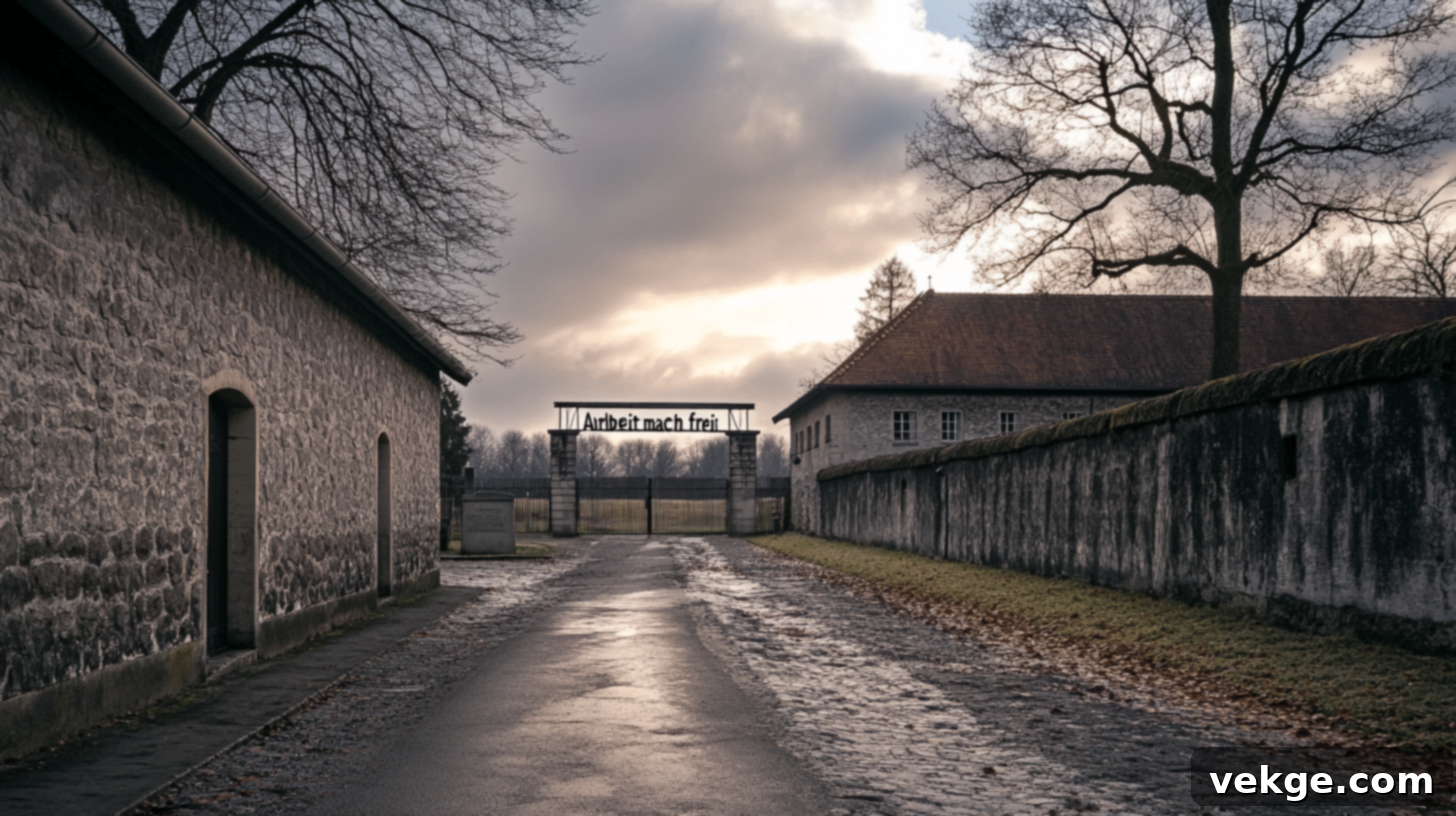
History and Importance: Established in March 1933, Dachau was the first Nazi concentration camp, originally intended for political prisoners. Over its twelve years of operation, more than 200,000 prisoners from various countries were held here, and tragically, over 41,500 lost their lives due to brutality, disease, starvation, and execution before the camp was liberated by US troops in April 1945. Today, it stands as a solemn memorial and a powerful educational site, dedicated to remembering the victims and ensuring such atrocities are never forgotten.
When to Visit: The memorial site is open year-round. A visit in winter can provide a particularly somber and reflective atmosphere, which many visitors find aligns with the gravity and historical significance of the site.
Local Travel Tips: To reach Dachau from Munich, take the S2 train (S-Bahn) for approximately 25 minutes, then transfer to local bus #726 directly to the memorial site. Allow a minimum of 3-4 hours to thoroughly explore the exhibitions, barracks, and other memorial structures, as it is a deeply moving and extensive experience.
Fun Facts: The infamous phrase “Arbeit macht frei” (Work sets you free) is inscribed on the entrance gate, a cynical and misleading motto used by the Nazis at several concentration camps.
9. Rothenburg ob der Tauber
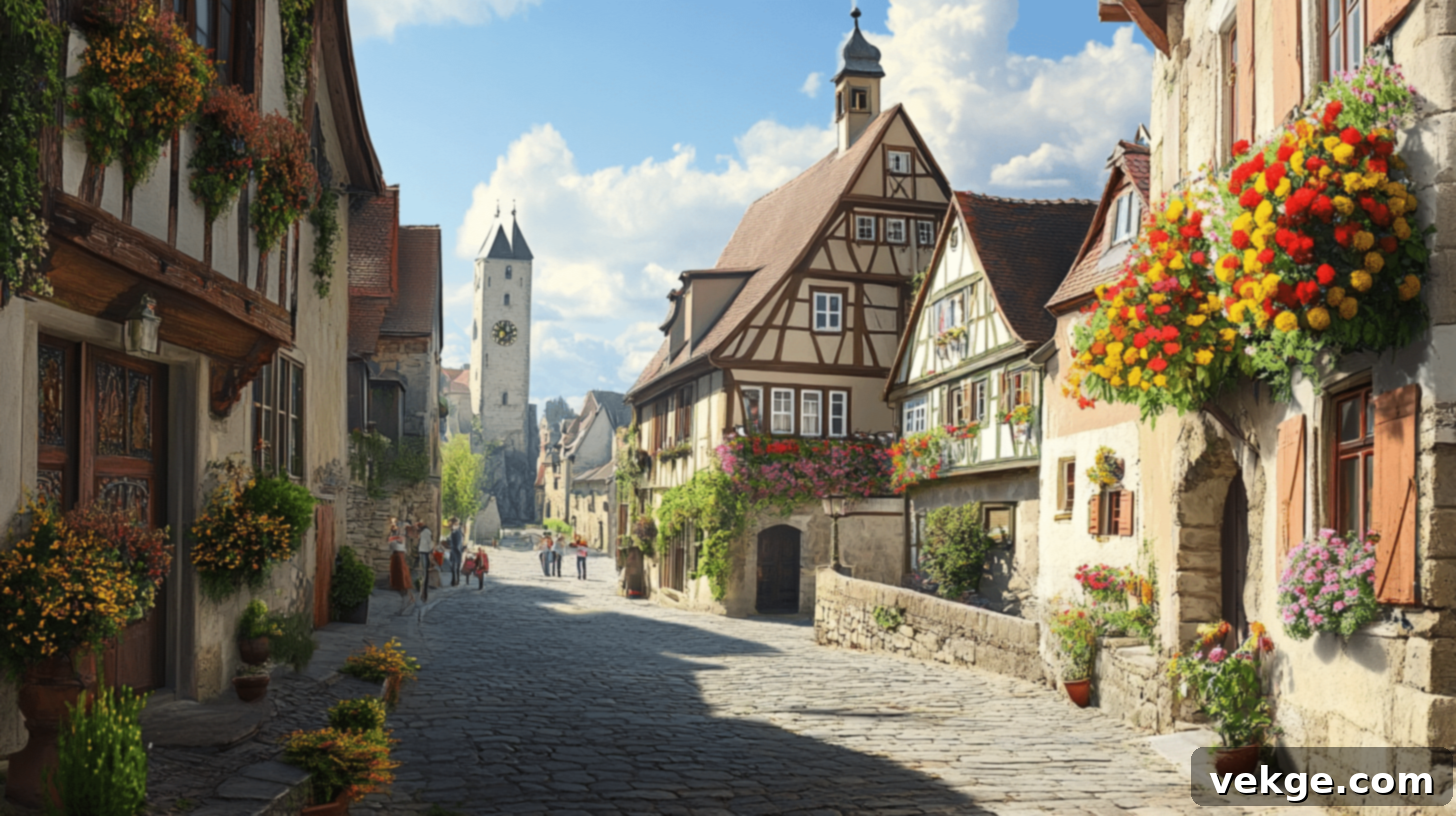
History and Importance: Founded in 1170, Rothenburg ob der Tauber reached the zenith of its prosperity during the Middle Ages as a Free Imperial City. Remarkably, it was largely spared from destruction during periods of modernization and conflict, allowing it to preserve its medieval German architecture almost entirely intact. Wandering through its cobblestone streets feels like stepping back in time, making it one of Germany’s most romantic and photogenic towns.
When to Visit: To avoid the largest summer crowds, consider visiting between March and May or in September and October. The town is particularly magical in December when its renowned Reiterlesmarkt (Christmas Market) transforms Rothenburg into a true winter fairy tale.
Local Travel Tips: For the most authentic experience, consider staying overnight. Once the day-trippers depart, the town regains a peaceful, enchanting atmosphere. Don’t miss walking the complete circuit of the town wall, a 2.5 km (1.5 miles) path that offers stunning views over the town and the surrounding Tauber Valley.
Fun Facts: Rothenburg was famously saved from extensive bombing during World War II when a US Assistant Secretary of War, familiar with the town’s unique beauty, interceded and spared it from a planned artillery attack.
10. Berlin Cathedral (Berliner Dom)
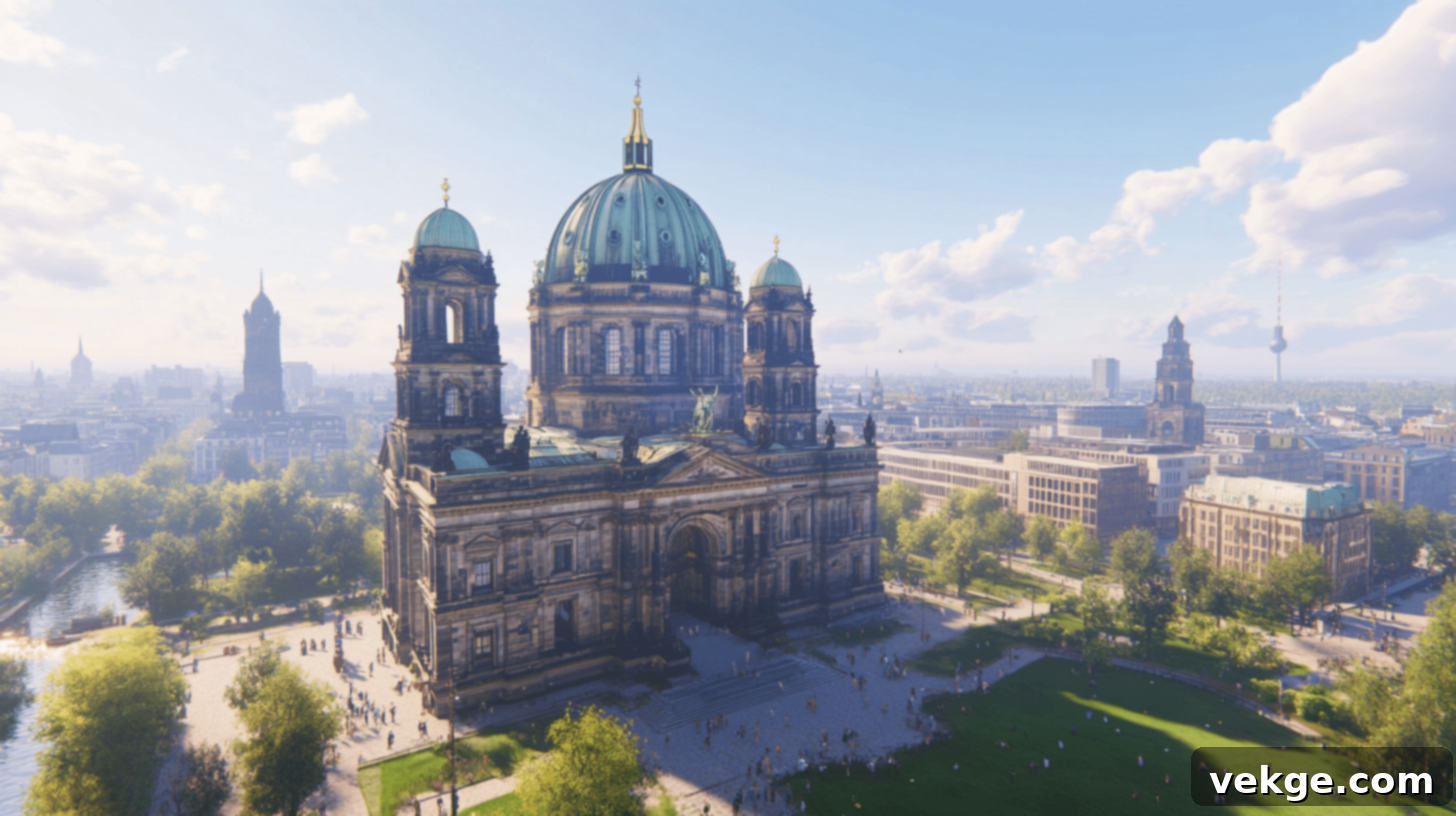
History and Importance: The imposing Berlin Cathedral, completed in 1905 in a grand neo-Renaissance style, stands on a site where churches have existed since 1465. Severely damaged during World War II, its extensive restoration process was not fully completed until 1993, restoring it to its former glory. It serves as a prominent landmark on Museum Island and a significant Protestant church in Germany.
When to Visit: Weekday mornings typically offer the most peaceful atmosphere for exploring the cathedral’s magnificent interiors. Attending one of the special evening concerts provides a unique and acoustically impressive experience within this grand setting.
Local Travel Tips: For truly spectacular panoramic views of Berlin’s cityscape and Museum Island, be sure to climb the 270 steps to the dome walkway. A combined ticket that includes entry to some of the nearby museums on Museum Island can often save you money.
Fun Facts: The crypt below the cathedral, known as the Hohenzollern Crypt, houses nearly 100 sarcophagi and burial monuments belonging to members of the Prussian royal Hohenzollern dynasty, making it one of the most important dynastic burial sites in Germany.
11. Museum Island, Berlin (Museumsinsel)
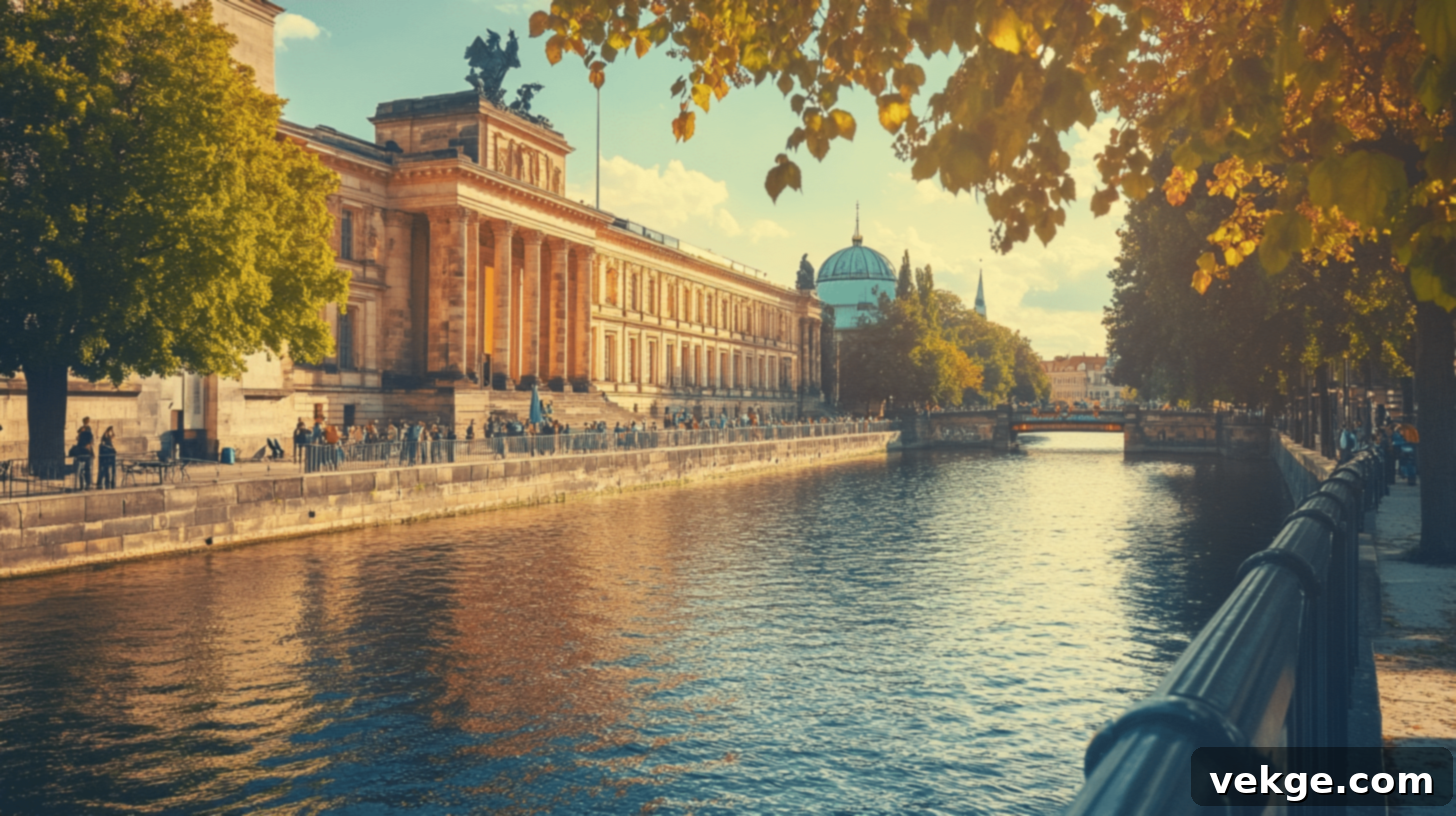
History and Importance: A unique and globally significant ensemble, Museum Island is a complex of five world-renowned museums, built between 1830 and 1930. Recognized as a UNESCO World Heritage site in 1999, this cultural powerhouse houses an incredible array of treasures, spanning from ancient Egyptian artifacts, including the iconic bust of Nefertiti, to classical antiquities and 19th-century European art.
When to Visit: To avoid the largest crowds, particularly during peak tourist season, consider visiting on Thursday evenings when many museums offer extended opening hours. Winter weekdays are generally the quietest times, allowing for more contemplative exploration of the collections.
Local Travel Tips: For cost savings, especially if you plan to visit multiple museums, consider purchasing a Berlin WelcomeCard (which includes transport) or a dedicated Museum Pass. Many visitors find it best to start with either the Pergamon Museum (currently under partial renovation) or the Neues Museum due to their immensely popular collections.
Fun Facts: After the devastation of World War II, Museum Island was largely in ruins. Many of its precious collections were split between East and West Berlin for decades, only to be gradually reunited and restored after Germany’s reunification in 1990.
12. Zugspitze

History and Importance: Reaching an impressive height of 2,962 meters (9,718 feet) above sea level, the Zugspitze is Germany’s highest mountain. It was first successfully climbed in 1820, marking a significant achievement in alpinism. The mountain is home to three remaining glaciers on its slopes, though sadly, these are shrinking rapidly due to the effects of climate change, making it a poignant symbol of environmental shifts.
When to Visit: May to October offers excellent conditions for hiking and enjoying the mountain’s summer activities. December to March is prime time for skiing and other winter sports. To avoid the busiest periods, try to steer clear of public holidays and summer weekends.
Local Travel Tips: You have a choice of scenic routes to the summit. The fastest and most direct option is taking the cable car from Eibsee, offering spectacular aerial views. Alternatively, the cogwheel train from Garmisch-Partenkirchen provides a more leisurely and equally scenic journey through the mountain landscape.
Fun Facts: The summit of the Zugspitze is uniquely split between Germany and Austria. Visitors can observe border markers and even enjoy restaurants and facilities from both countries at the very top, offering an international mountain experience.
13. Black Forest (Schwarzwald)
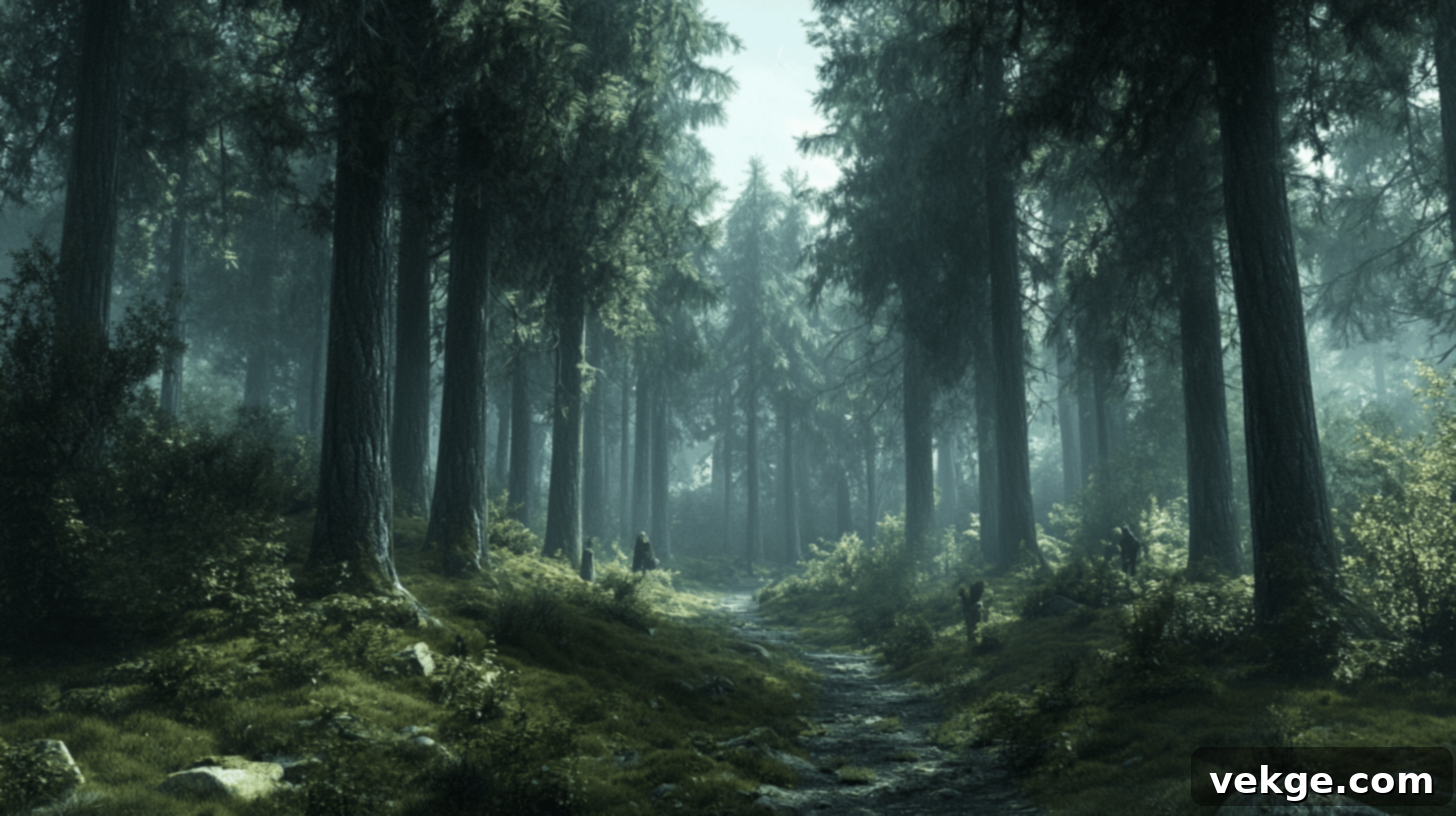
History and Importance: The Romans, struck by its dense, dark canopy of fir trees, aptly named this mystical region the “Black Forest” (Silva Nigra). This enchanting landscape, with its rolling hills, deep valleys, and quaint villages, has inspired countless legends and notably served as the backdrop for many of the Brothers Grimm’s beloved fairy tales. It is also the birthplace of iconic German traditions, including the intricate cuckoo clocks and the world-famous Black Forest gateau (Schwarzwälder Kirschtorte).
When to Visit: April through October is generally the best time for hiking, cycling, and exploring the region’s natural beauty. July and August are perfect for lake swimming and water sports. Winter transforms the Black Forest into a picturesque wonderland, ideal for skiing, snowshoeing, and visiting charming Christmas markets.
Local Travel Tips: For convenient exploration, consider basing yourself in vibrant cities like Freiburg or picturesque towns such as Titisee. If you plan extensive travel within the region, purchasing a Black Forest Card (SchwarzwaldCard) can offer free public transport and discounts on many local attractions.
Fun Facts: The world’s first cuckoo clock is believed to have been invented here around 1730, evolving into an enduring symbol of German craftsmanship. The Black Forest is also renowned for its numerous mineral springs, which feed famous thermal spas, offering relaxation and wellness amidst nature.
14. Rhine Valley (Mittelrheintal)
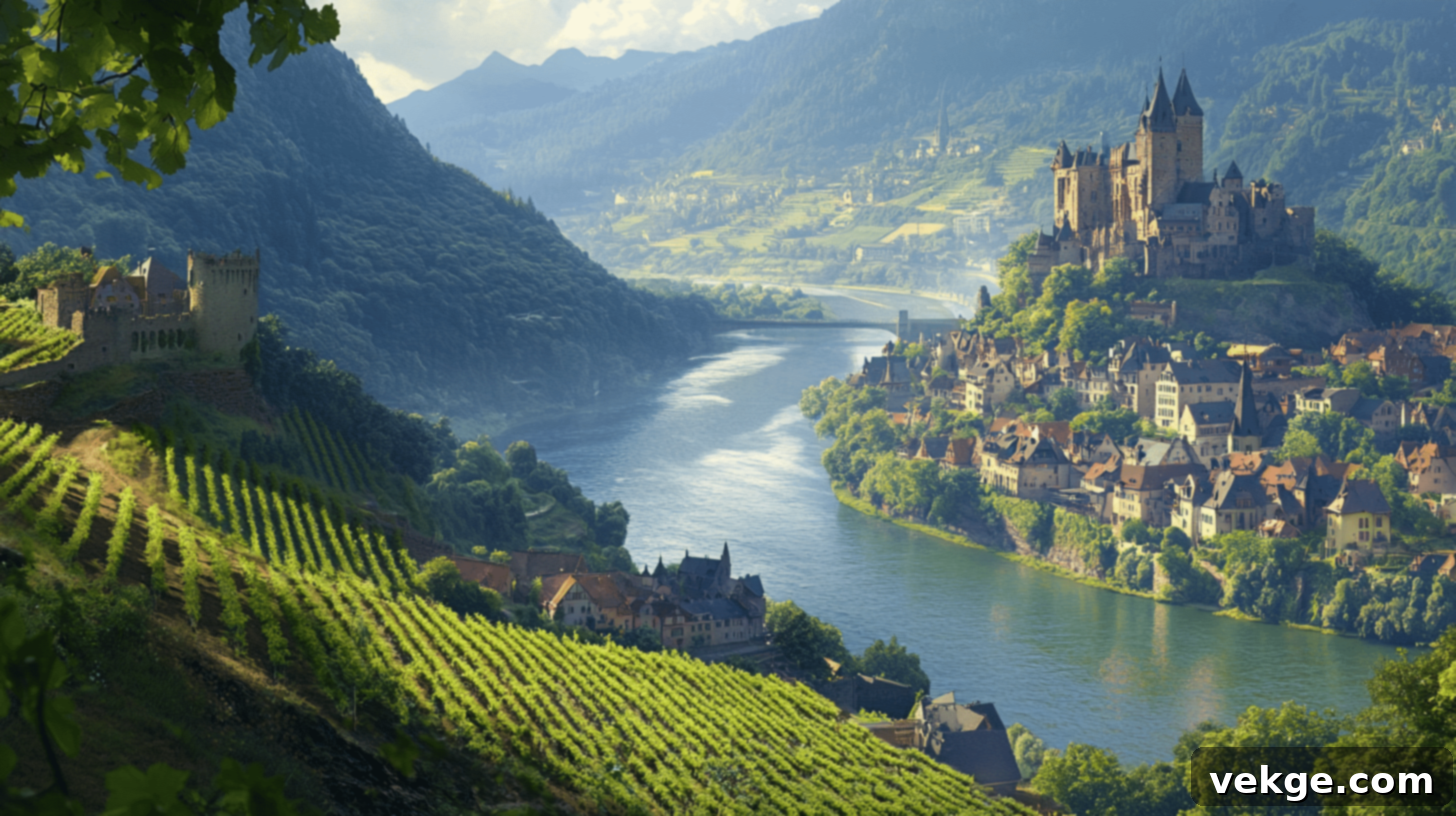
History and Importance: The Upper Middle Rhine Valley, a stunning stretch of the Rhine River, was designated a UNESCO World Heritage site in 2002 for its extraordinary cultural landscape. Its strategic importance dates back to Roman times when vineyards were first established, and numerous medieval castles and fortresses dotted the landscape, controlling vital river commerce and trade routes. This romantic valley is steeped in history and legend.
When to Visit: The period from May to October is perfect for enjoying scenic boat trips along the river, which offer the best views of the castles and vineyards. September and October are particularly delightful, as the region comes alive with vibrant wine festivals and the bustling activity of the grape harvest season.
Local Travel Tips: Trains run conveniently along both riverbanks, making it easy to hop on and off to explore various towns and castles. For maximum flexibility and value, consider buying a KD Rhine Pass, which offers unlimited travel on their popular boat services, allowing you to experience the valley at your own pace.
Fun Facts: The Rhine boasts an unparalleled concentration of castles in one area than any other river in the world, with over 40 magnificent fortresses, ruins, and palaces packed into the Middle Rhine section alone, each with its own captivating story.
15. Heidelberg Castle (Heidelberger Schloss)
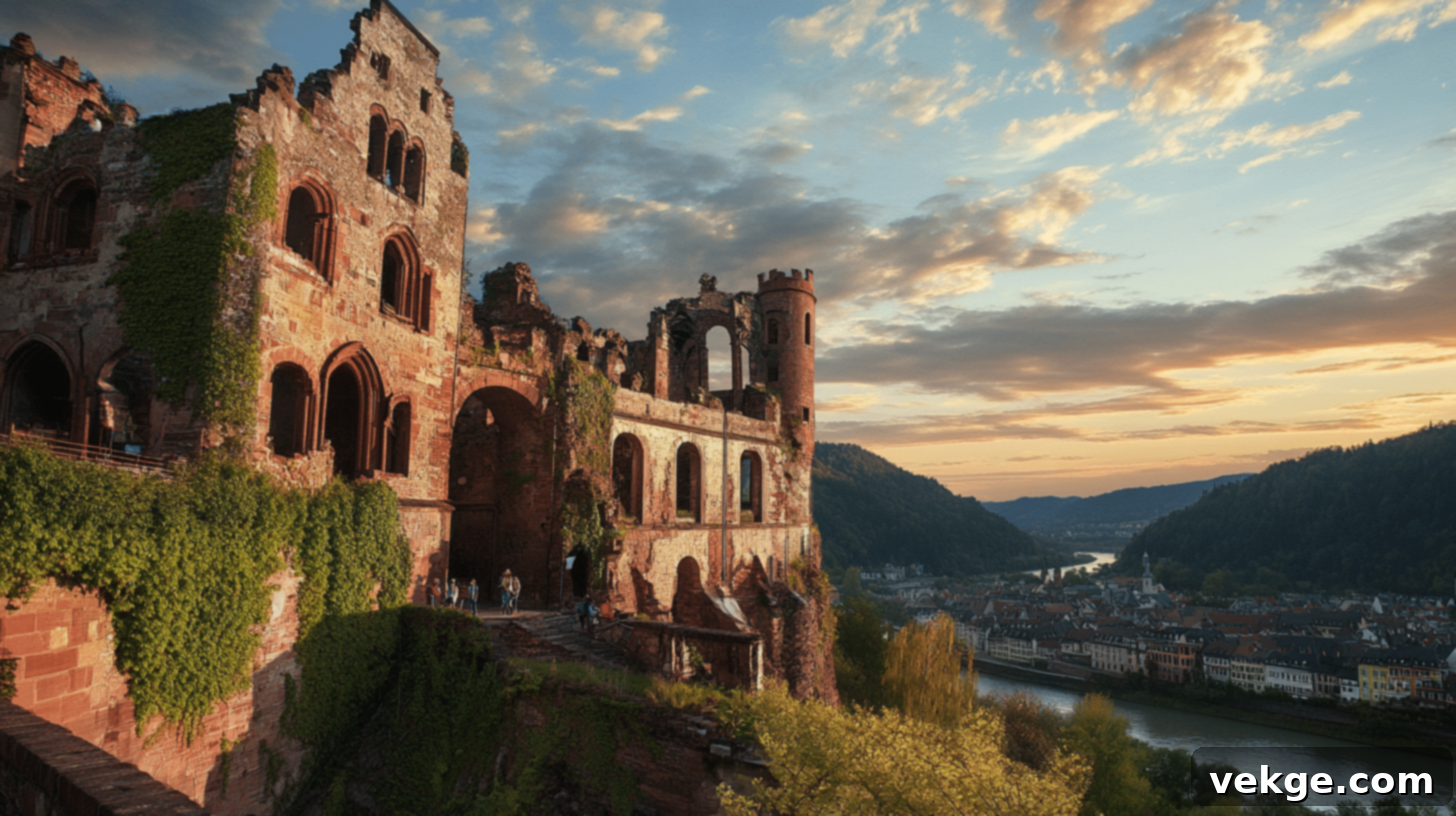
History and Importance: Perched majestically above the city, Heidelberg Castle, with its origins in the 13th century, was expanded and embellished over generations by powerful Palatine Electors. Though partially destroyed by lightning strikes and the ravages of war, its romantic ruins have profoundly influenced German Romanticism, drawing poets, artists, and travelers for centuries. It remains one of Germany’s most iconic and frequently visited landmarks.
When to Visit: To avoid the bustling summer crowds, plan your trip during the shoulder seasons of April-May and September-October. For an especially magical experience, try to visit during the first Saturdays of June, July, and September, when the castle ruins are spectacularly illuminated by fireworks, recreating the historic fires that damaged it.
Local Travel Tips: Save yourself the uphill walk by taking the convenient funicular railway from Kornmarkt square directly to the castle. Visiting early in the morning or late in the afternoon often allows for a more peaceful exploration of the grounds and provides excellent lighting for photography.
Fun Facts: The castle cellar is home to the world’s largest wine barrel, the “Heidelberg Tun.” Built in 1751, this colossal barrel has a staggering capacity of 220,000 liters (approximately 58,000 gallons), though it’s no longer used for wine storage.
16. The Lorelei Rock
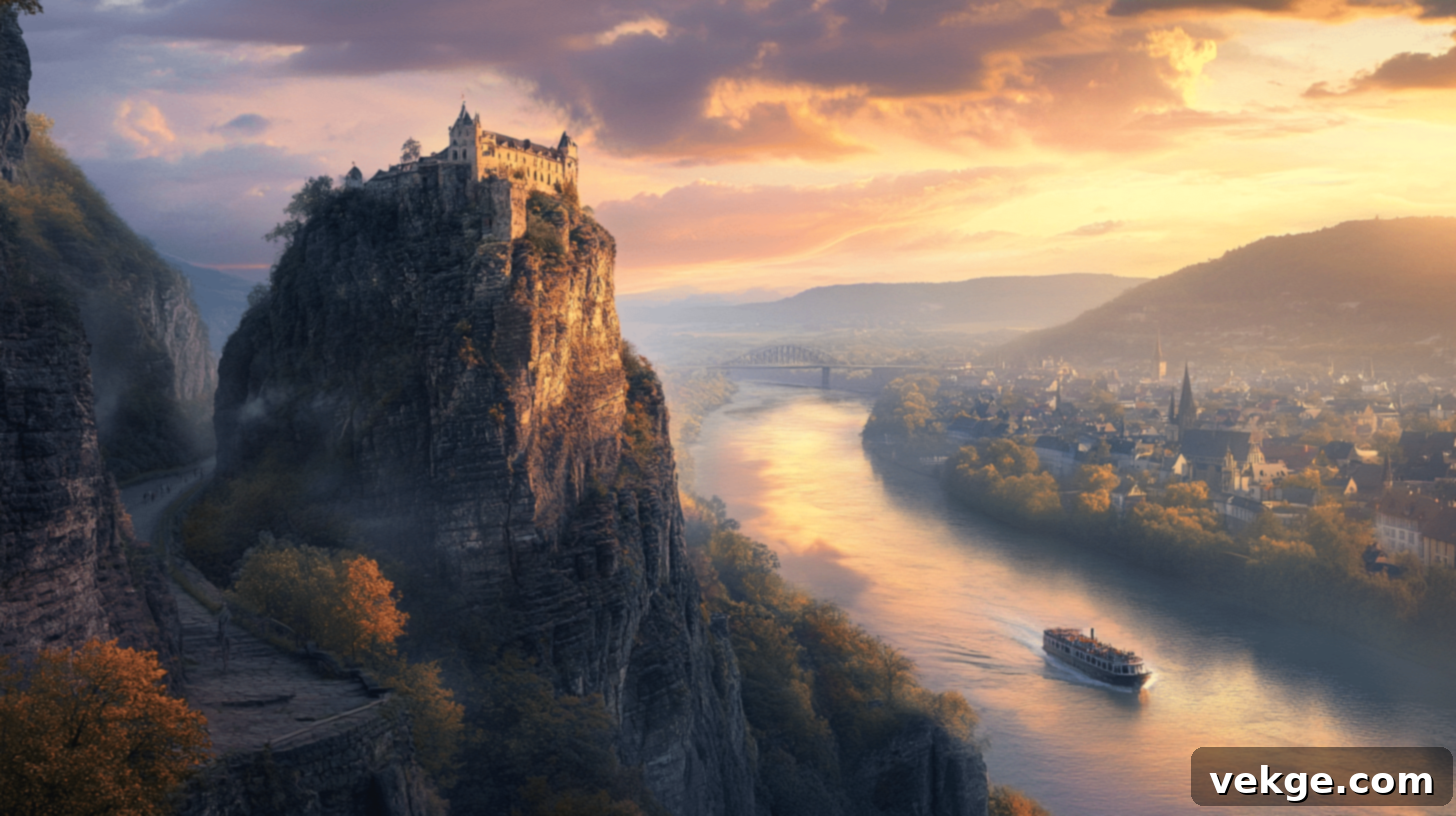
History and Importance: This towering 132-meter (433 feet) slate rock outcrop dramatically marks the narrowest and historically most treacherous point of the Rhine River. It gained immortal fame through Heinrich Heine’s 1824 poem, “Die Lorelei,” which tells the captivating legend of a beautiful siren who lured sailors to their doom with her enchanting singing, causing their ships to wreck on the perilous rocks below. This myth embodies the romantic and sometimes dangerous allure of the Rhine.
When to Visit: The best time to experience the Lorelei is from May to October, coinciding with the main operating season for Rhine River boat trips, which offer direct views of the rock from the water. Summer evenings are particularly pleasant for enjoying sunset views from the viewpoints above.
Local Travel Tips: You can experience the Lorelei from various perspectives: take a boat trip along the Rhine for a water-level view, or ascend to the viewpoints above via hiking trails for expansive panoramic vistas. The closest train station for easy access is St. Goarshausen, located directly at the foot of the rock.
Fun Facts: The rock’s peculiar echoing effect, caused by the unique acoustics of the river valley, is widely believed to have inspired the legendary siren’s song. Before the advent of modern navigation technology, historical records indicate that over 500 ships reportedly met their demise in this challenging stretch of the Rhine.
17. Miniatur Wunderland, Hamburg
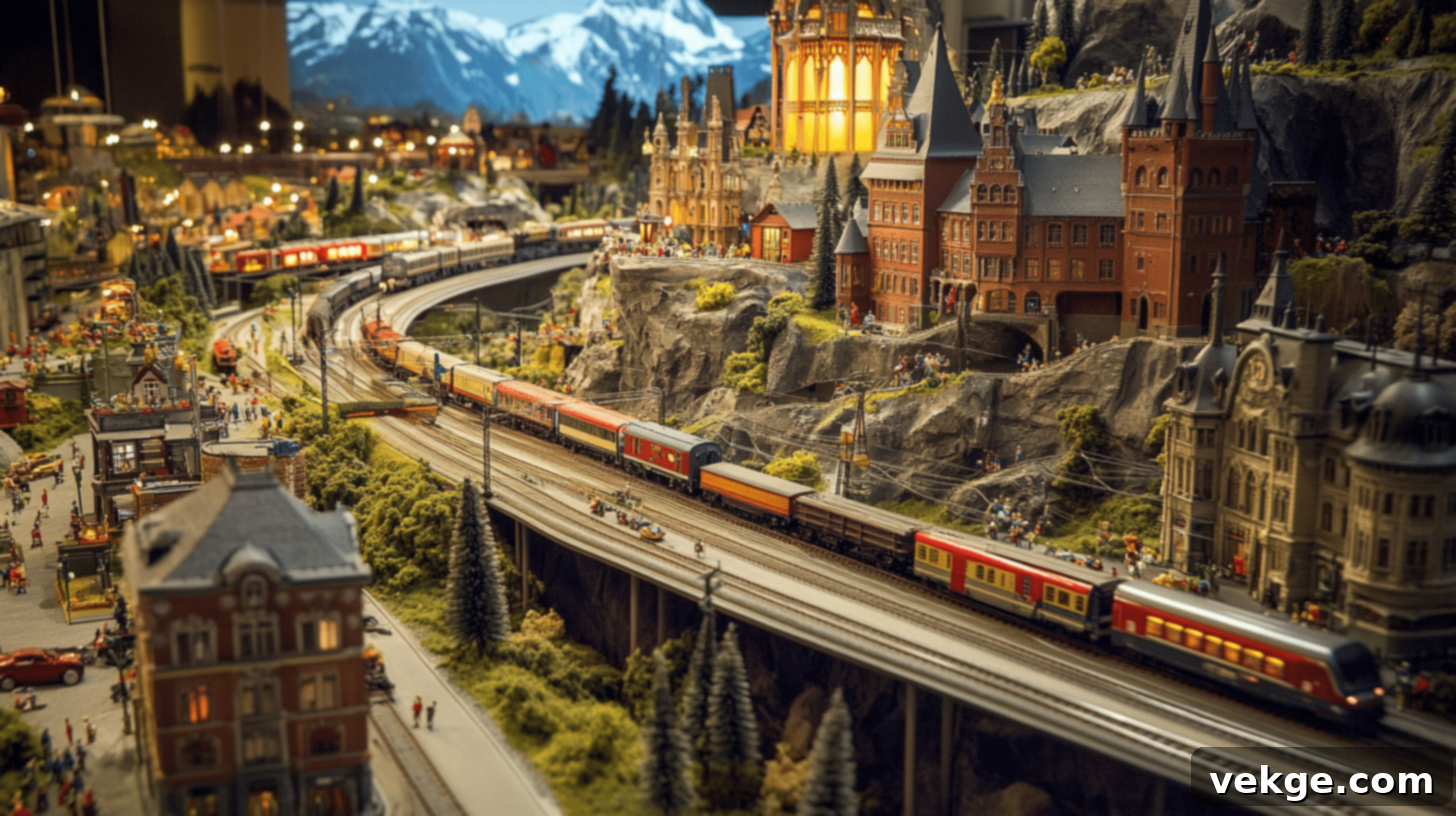
History and Importance: Opened in 2000, Miniatur Wunderland has rapidly grown to become the world’s largest model railway exhibition and one of Germany’s most popular tourist attractions. This incredibly detailed miniature world features nine themed sections that meticulously recreate famous regions like Hamburg, the Swiss Alps, Scandinavia, and America, alongside a fully functional miniature airport with planes taking off and landing. It’s a marvel of engineering and artistic dedication.
When to Visit: To best enjoy the intricate details and avoid the largest crowds, weekday mornings, especially on Tuesdays or Wednesdays, are highly recommended. It’s crucial to book your tickets online for a specific entry time, as this helps manage visitor flow and ensures your admission.
Local Travel Tips: Miniatur Wunderland is conveniently located in Hamburg’s historic Speicherstadt warehouse district, a UNESCO World Heritage site in itself. Most visitors find they need at least 3 hours to explore the various sections, but many enthusiasts easily spend an entire day marveling at the countless scenes and hidden details.
Fun Facts: This colossal miniature world boasts an astonishing 1,040 trains, over 4,340 buildings, 385,000 lights, and more than 260,000 miniature figures, each meticulously placed to tell a story. The entire exhibition operates on a continuous day-night cycle, changing every 15 minutes to showcase the varying lighting and atmospheric effects.
18. Schloss Charlottenburg, Berlin
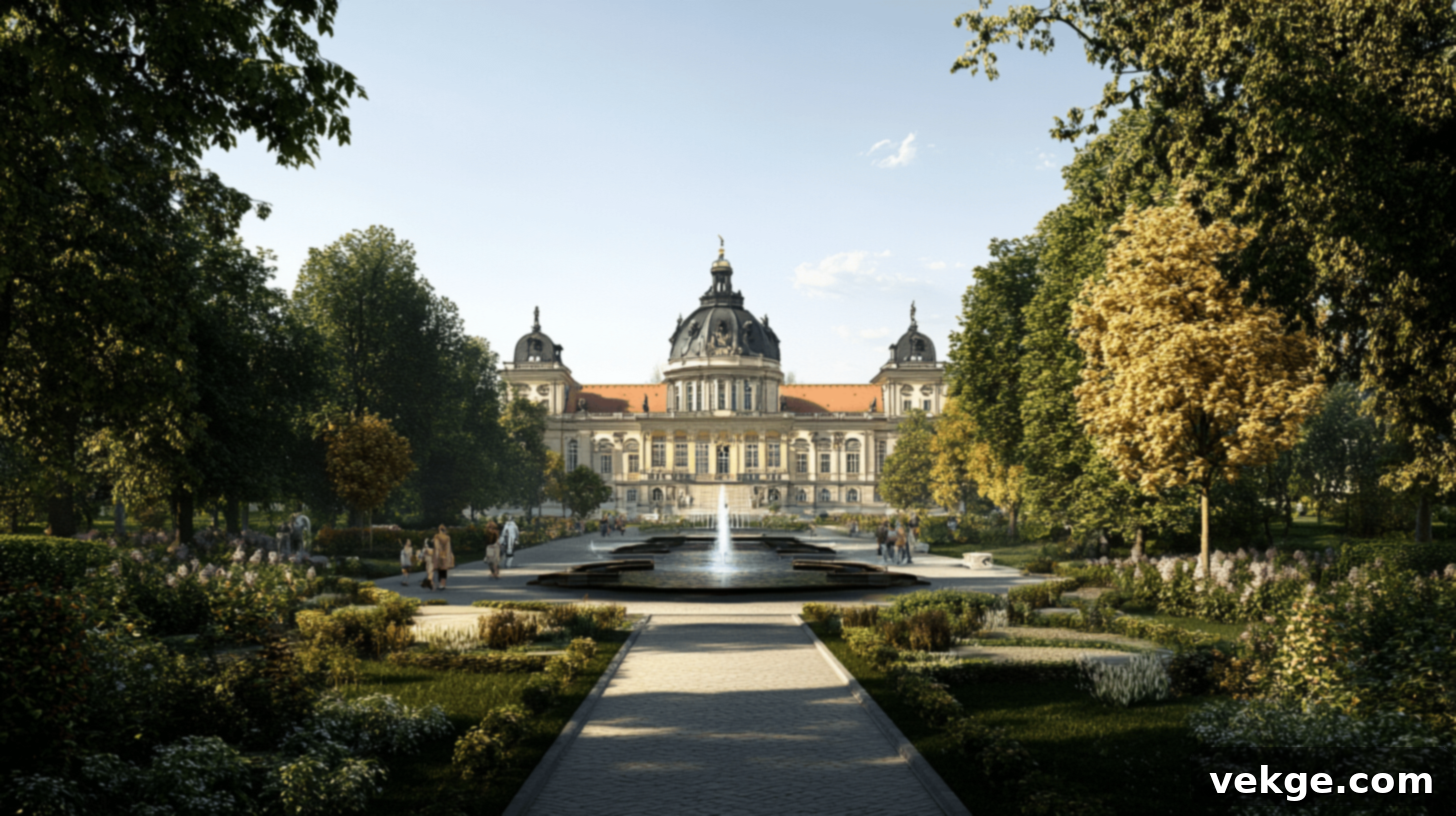
History and Importance: Built between 1695 and 1713, Schloss Charlottenburg began as a modest summer palace for Sophie Charlotte, the beloved wife of Friedrich I, the first King in Prussia. Over time, it was significantly expanded by subsequent rulers, most notably by Frederick the Great, transforming it into Berlin’s largest and most magnificent palace. It stands as a splendid example of Baroque and Rococo architecture, reflecting centuries of royal grandeur and artistic tastes.
When to Visit: The months of April to June and September to October are ideal for enjoying the palace’s extensive and beautifully manicured gardens. In December, the palace grounds host one of Berlin’s most picturesque Christmas markets, adding a festive charm to the historical setting.
Local Travel Tips: Be aware that both the palace and its gardens are typically closed on Mondays for maintenance. Arriving early in the day is advisable to allow ample time to explore both the lavish palace interiors and the sprawling grounds without feeling rushed. An audio guide is highly recommended to fully appreciate the history and significance of the various rooms and collections.
Fun Facts: The central dome of the palace originally featured an elaborate gold-plated weather vane, which ingeniously combined a clock, a compass, and a barometer, showcasing the era’s blend of artistry and scientific curiosity.
19. Sanssouci Palace, Potsdam
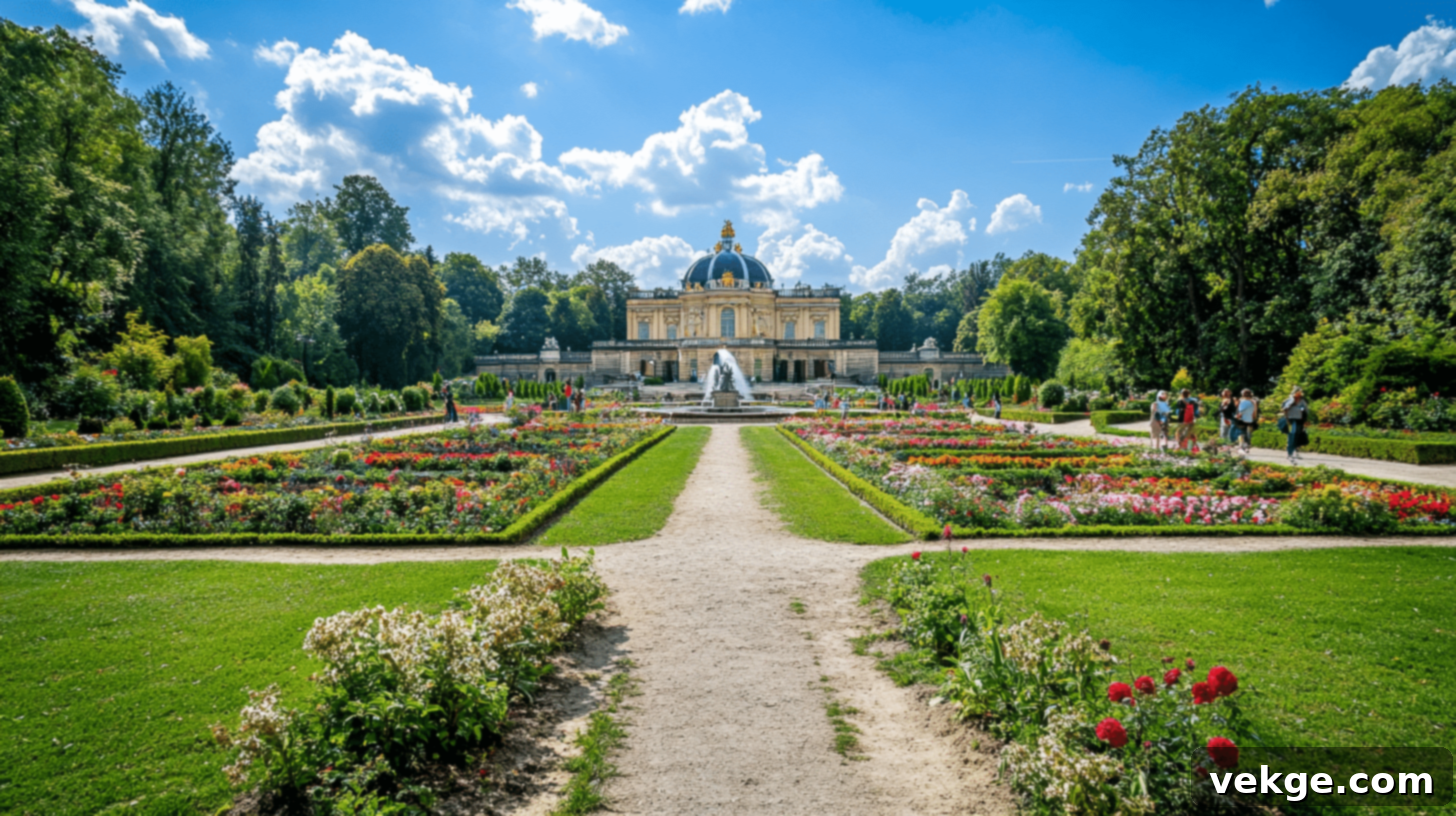
History and Importance: Constructed between 1745 and 1747, Sanssouci Palace was designed as a private, intimate retreat for Frederick the Great, King of Prussia. Its name, “sans souci,” is French for “without worries,” perfectly encapsulating the king’s desire for a personal sanctuary away from the rigid formalities of court life. The single-story Rococo design, with its elegant terraced vineyards, beautifully reflected Frederick’s personal tastes and philosophical ideals, prioritizing comfort and aesthetics over ostentatious royal grandeur.
When to Visit: April and May are particularly charming months to visit, as the palace gardens burst into bloom with vibrant spring flowers. Planning your visit on a weekday will help you avoid the larger crowds that typically gather on weekends, allowing for a more tranquil experience.
Local Travel Tips: To make the most of your visit to Potsdam’s many royal residences, consider purchasing a combined ticket that grants access to multiple palaces, offering both convenience and savings. From Berlin, you can easily reach Potsdam via a regional train, then take local bus #695, which stops directly at the palace grounds.
Fun Facts: In a testament to his strong bond with his canine companions, Frederick the Great is buried on the palace grounds, specifically on the top terrace next to his beloved dogs, fulfilling his personal wish despite initial opposition from later rulers.
20. The Fairy Tale Road (Deutsche Märchenstraße)
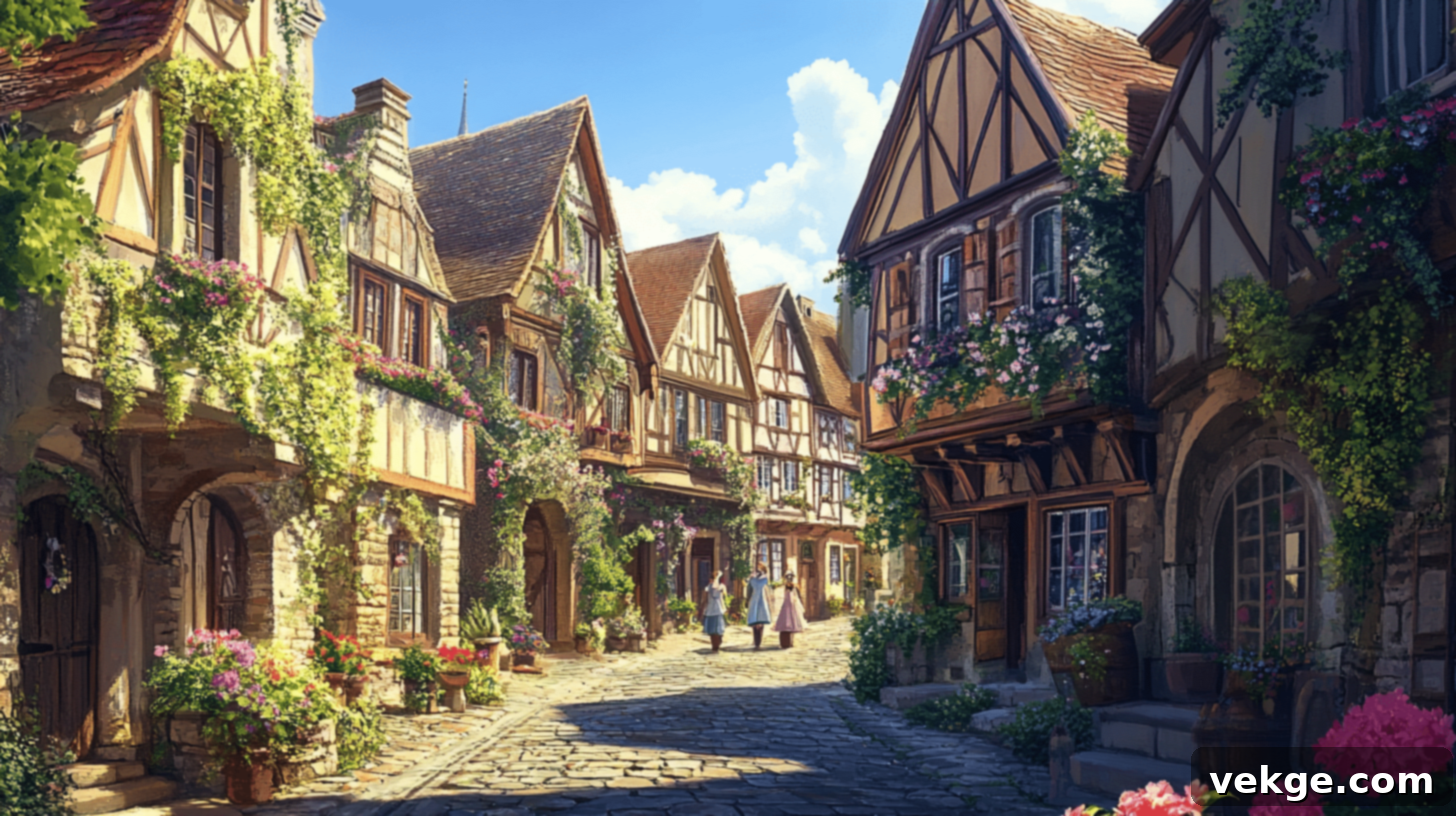
History and Importance: Established in 1975, the German Fairy Tale Road is a delightful 600-kilometer (370-mile) scenic route that winds its way through central Germany. It links towns, landscapes, and landmarks intrinsically associated with the Brothers Grimm – Jacob and Wilhelm Grimm – who meticulously collected and published their iconic folk tales while working as librarians and linguists. This enchanting route brings their beloved stories, from Rapunzel to Little Red Riding Hood, to life.
When to Visit: April to October offers the best weather for exploring the route by car or bike, with pleasant temperatures and longer daylight hours. December, however, offers a uniquely magical experience, as many of the medieval towns along the road host charming Christmas markets, transforming them into festive fairy-tale settings.
Local Travel Tips: Renting a car provides the greatest flexibility to explore the numerous towns, castles, and natural sites at your own pace. Key stops along the route include Hanau (the birthplace of the Brothers Grimm), Marburg (where they studied), and the Hanseatic city of Bremen, home to the famous Town Musicians statue.
Fun Fact: The Grimms’ first edition of “Children’s and Household Tales,” published in 1812, was not originally intended for children. Its tales were considerably darker, more violent, and less sanitized than the popular, softer versions we know and love today.
Conclusion: Your Unforgettable German Adventure Awaits!
As you meticulously plan your German adventure, remember that these famous buildings, iconic landmarks, and stunning natural wonders offer a truly perfect fusion of natural beauty, rich history, and profound cultural significance. This comprehensive guide has aimed to take you on a virtual journey, from the charming cobblestone streets of medieval towns to the soaring spires of impressive cathedrals, the serene tranquility of peaceful lakes, and much, much more.
Germany consistently rewards its visitors with authentic, deeply enriching experiences and a diverse array of stunning sights that etch themselves into memory. The practical information we’ve meticulously shared—from avoiding crowds and saving money to discovering the best ways to experience each unique location—is designed to empower you to create a personalized and hassle-free trip.
Ultimately, Germany’s diverse attractions eloquently tell the story of a dynamic nation where ancient traditions gracefully intertwine with modern life, all set against a backdrop of varied and captivating landscapes. Embrace the journey, immerse yourself in the culture, and let Germany’s magic unfold before you.
For more interesting travel insights and inspiring destinations, be sure to explore our website!
